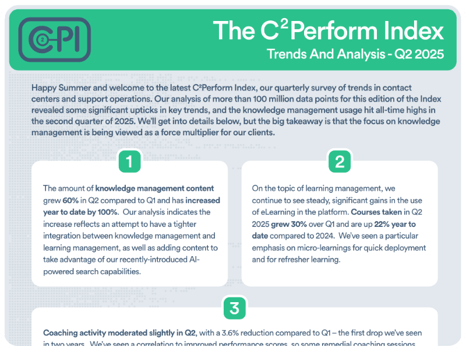All growing businesses that are hitting their revenue goals share one common characteristic. They put the customer first.
They don’t just talk the talk. They invest in providing an optimal customer experience at all touchpoints throughout the entire customer lifecycle. And contact centers and customer support professionals play a vital role in delivering this omnichannel experience.
Unfortunately, when businesses don’t pay enough attention to supporting their customer base, they lose big. In fact, bad customer service costs businesses more than $75 billion per year.
Fortunately, there are several ways contact centers can improve how they serve their customers. Specially, they can invest in employee learning and knowledge management.
With a clear strategy on training and ongoing education, contact center teams are equipped to keep their customers happy while keeping their employees engaged. Knowledge base creation and management is an essential part of delivering a high quality level of service that meets the needs of modern customers.
Why Knowledge Base Creation Is Important for Contact Centers
Contact centers are places where customers go to get help with product or service-related issues. Because of the nature of the work and due to the high volume of inbound customer inquiries each day, contact center employees need to be able to quickly and accurately solve customer problems. This requires having access to a strong knowledge base.
A knowledge base is a collection of information that is organized and easily accessible. Knowledge bases can be used to store FAQs, product information, company policies, or any other type of data that agents might need to reference when assisting customers.
Creating and maintaining a knowledge base is essential for any contact center that wants to provide excellent customer service. They help employees find answers to customer questions quickly and efficiently. They also help to ensure that all employees are on the same page, with the most up-to-date information.
Here are some other notable reasons why contact centers need to create knowledge bases:
- To help employees learn new information more quickly and efficiently.
- They provide a central repository for employee training materials and knowledge base articles.
- They help managers track employee training progress and identify areas where employees need more development.
- To reduce the amount of time spent on training by providing employees with a self-service resource for learning new information and improving their customer service skills.
- To improve customer satisfaction by providing employees with quick and easy access to the information they need to resolve customer issues.
- Customer-facing knowledge bases help reduce the number of calls to the contact center by providing customers with a self-service resource for finding answers to their questions.
- They improve contact center operations by providing managers and employees with easy access to important information.
As you can imagine, knowledge base creation and management can be a daunting task. However, it’s essential for ensuring that agents have the information they need to provide outstanding customer service.
Knowledge Base Creation Tips for Contact Centers
Follow along with these best practices on creating and managing a knowledge base:
Start with a Clear Purpose
When creating a knowledge base for your contact center, start with a clear understanding of why you’re embarking on this. Ask yourself what type of information you want to include in the knowledge base and how it will be used by agents.
You also want to consider creating a customer-facing knowledge base to help them solve issues on their own. If this is the case, you can impress your existing customers with informative, engaging content that helps them achieve a goal or solve a problem.
Once you have a good understanding of the purpose of the knowledge base, you will know exactly who you’re creating content for and how to structure the information.
Define the Structure of Your Knowledge Base
How will your articles be organized? What categories will you use? How will users search for knowledge base content? Are you providing video and other media to supplement written instructions?
Answering these questions will help you to create a structure that is both user friendly and easy to maintain. With a clear structure, you can consider organizational methods that fit each segment of your audience.
For example, you can create a password-protected internal knowledge base with clear permission sets for each team in your organization. For the customer knowledge base, you can categorize content by where the customer is in their lifecycle. This may include topics like creating your account, managing your billing, and tutorials.
Find the Best Knowledge Base Software
There are a number of knowledge base software options available, so be sure to take the time to find the best option for your contact center. Consider your needs and budget when selecting knowledge base software, and be sure to read online reviews on sites like G2 to get a sense of what other users think of the software.
Make sure the knowledge management platform you’re using fits the goals of your knowledge base strategy. For example, if your employees are more engaged with video, make sure the knowledge base software you’re using provides capabilities to embed rich media.
Research Topics for Your Articles
Once you find the right software, you’re ready to start creating all the awesome content you need to help develop employee knowledge across your teams. Begin by researching topics that would be relevant and useful for your agents.
Consider the type of questions that agents typically receive, and look for opportunities to provide them with self-service solutions. And don’t forget to lean on all your teams. Every person in your organization has a unique perspective that others don’t see in their day to day, so enlist the help of others.
For example, your product support team will know exactly what topics are commonly brought up during phone calls or through other customer support channels. Your contact center manager and team leads can provide context on how to support the employee onboarding process with helpful knowledge base content.
Create Content for Specific Topics
Once you have identified some potential topics, it’s time to start writing articles. Be sure to include clear and concise instructions, and use screenshots or videos if they would be helpful.
If possible, test the knowledge base article from the perspective of an agent to ensure that it’s easy to understand. Encourage team members to provide feedback via anonymous surveys. This way, you can refine it over time to better suit their evolving needs and interests.
Get Your Team Excited About Knowledge Management
The concept of knowledge and learning management sounds thrilling doesn’t it? When it comes to managing educational information within your organization, the task can feel overwhelming. There are so many things to know for each role within contact center teams.
And some of the information may be dry. However, it’s important to promote your knowledge base content to your team members. Show them how to access and use it. Encourage agents to use the content by offering rewards or incentives. For example, give public shout outs during team meetings or send active knowledge base users gift cards.
Get a Complete Employee Engagement and Performance Management Tool
Knowledge management is just one piece of the puzzle for enhancing your customer experience. A successful contact center is one that invests in their staff and supports them with training, coaching, recognition programs, and various other engagement tools.
When a contact center employee is happy, performance, engagement, and retention improve. In fact, a recent McKinsey & Company survey found that engaged, satisfied employees at call centers are nearly nine times more likely to stay than leave within a year, and they’re 3.3 times more likely to feel extremely empowered to resolve customer issues.
Empower your team with C2Perform’s suite of applications that help contact centers thrive. Teams that use C2Perform don’t just leave their knowledge bases to collect dust and become forgotten. Employees are engaging with all kinds of learning management systems, including knowledge bases, and learning activity is continually on the rise for our users.
Schedule a free demo of our knowledge management platform to see how we can help you create and optimize your knowledge base so you can continue to deliver awesome customer service while keeping employees happy and engaged.
 English
English Español
Español





.png?height=350&name=Untitled%20(300%20x%20175%20px).png)



